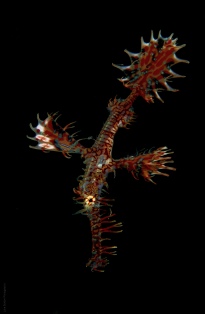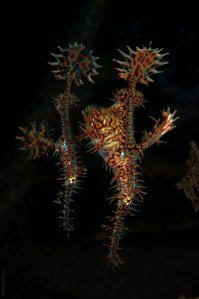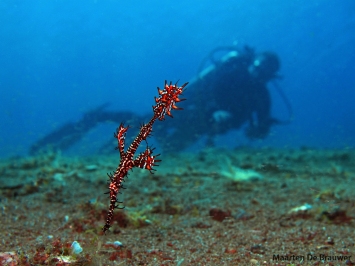So far most of the critters I’ve written about were true benthic ones; Frogfishes, Scorpionfishes, Pipefishes, they all spend the vast majority of their time laying on the bottom. The next little guys are a bit different, they are (only slightly) less lazy and spend their time hovering close the bottom. May I present to you the Ornate Ghostpipefish!
The Ornate Ghostpipefish (Solenostomus paradoxus) is another one of those truly bizarre creatures you can find when you have a good look around you while diving. They look very flamboyant and ornate, but they are remarkably hard to spot. The fact that they don’t get bigger than 12cm might have something to do with that. So if you’ve never seen them before, it might take the help of a friendly diveguide to have the pleasure of seeing them.
Ghostpipefishes belong to the order (=one level up from family) of “Syngnathiformes”, which is the same order in which you’ll find seahorses and pipefishes, but also razorfishes and even trumpetfishes and cornetfishes! So all these weirdly shaped critters are related in one way or another.

Male Ornate Ghostpipefish (Picture by Luke Gordon)
There still is a lot of confusion about how many species of Ghostpipefish actually exist, but there seem to be at least four. For this post, I’m sticking to the best known and most flashy one. Describing an Ornate Ghostpipefish to someone who’s never seen one is interesting. Usually it goes a bit like this: “It’s a fish that swims upside down, with the head of a seahorse, a wide fan-like tail, a pouch like a kangaroo and it has got little filaments growing all over its body….Oh, and it also changes colour, any colour you’d like. Really, it’s a thing that actually exists!!!” Luckily there are plenty of photos to prove it.
While Ghostpipefishes are closely related to seahorses, there are a few major differences. As you may or may not know, in seahorses it’s the male that gets pregnant and gives birth. Ghostpipefishes are a bit more old-fashioned and don’t want anything to do with that modern male kind of stuff. With them, it’s the female that has a brooding pouch, gets pregnant and gives birth. Although there might be a little twist…Very little is known about them, but it is believed (not proven) that all Ghostpipefishes start out as males and later change sex to become female.
There is a LOT more we don’t know about Ghostpipefishes. For example, we don’t have a clue how long they live and it’s unknown how long they float in the open ocean as larvae. It looks like these animals spent most of their lives as larvae, floating around and then only “settle” to mate, after which they supposedly die. None of this has been properly tested, as Ghostpipefishes are notoriously difficult to keep alive in aquaria, let alone breed them in captivity, making close observations or experiments to test these hypotheses very difficult.
If you do want to see them for yourself, or maybe you are even ambitious enough to solve these riddles in the name of science, here is where you’ll find them. They are mostly tropical species which can be found from the east coast of Africa all the way to Fiji, but they are spotted most frequently in Indonesia and Philippines. During the last months of surveying, we found the highest numbers in Dauin with Lembeh Strait a close second. They are usually found in areas with some current and always hide in larger objects such as featherstars. You can also look for them in seafans, black corals or even rubbish. Ghostpipefishes often hang out in small social groups, so if you find one have a close look around to maybe find some more.

Pair of Ornate Ghostpipefish – If you look closely, you can see the eggs in the pouch (Picture by Luke Gordon)
Once you’ve found them, try to see if there is a female, she’ll be the one with the brooding pouch. The pouch is formed by the pelvic fins and if you are lucky, you might be able to see eggs inside it. Unlike other brooding fish species, ghostpipefishes will have eggs in all stages of development, so at the same time there might be freshly laid eggs in there and eggs that are ready to hatch. As far as I am aware no photos or videos exists of the little ones hatching (let me know if you do!). But what really interests me is what happens to the little guys after they hatch and start drifting in the water column….




Pingback: A different look at Bali | Critter Research
Pingback: Fieldwork 2.0 | Critter Research
Pingback: Using SMURFs to catch baby fish | Critter Research
Pingback: Seahorse and pipefish collection | Critter Research
Pingback: What is a species? | Critter Research
Pingback: Critter Research
Pingback: How to take photographs underwater responsibly - We Mentor You 14
Pingback: How to take photographs underwater responsibly - We Mentor You 14
Pingback: How to take photographs underwater responsibly | GVI IT
Pingback: How to take photographs underwater responsibly | GVI POL
Pingback: Ambon and Halmahera fieldwork: Mini-blog 3 – Surveying Ambon’s reefs | Critter Research
Pingback: Fieldwork discoveries in corona times: Alor | Critter Research
Pingback: Weird fish in the world 2022 - Pure Bio Tech